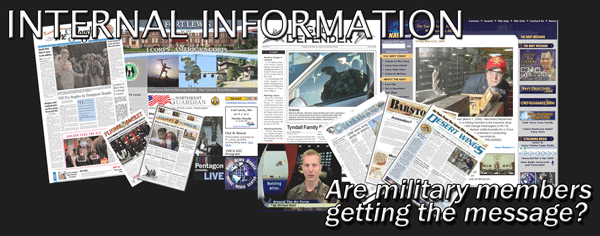On military installations, the base newspaper is considered the “voice of the commander” and its main function is codified in Public Affairs regulations and guidelines emphasizing the newspaper as the base’s primary internal communication product.
Much like newspaper readership in the civilian world, the number of troops who read the base newspaper has been on a steady decline. On a recent survey of Navy officers and enlisted personnel, the base/ship newspaper ranked in the bottom 15 as a “source of important information” while “Dining Hall/Mess Deck Conversations” were cited in the top 15 as a “source of important information” in a list that included both military and civilian media types (Navy Personnel Research, Studies, & Technology, 2005). When gossip is perceived to be more important than official newspapers, it is clear that the military needs to address how troops perceive and use internal media.
With readership on the decline, the Air Force even suspended publication of its flagship monthly magazine Airman, deciding to put content online only. (It later reconsidered and now publishes the magazine on a quarterly basis.) In contrast, online content at military websites, though largely targeted at outside audiences, has exploded. Internal base websites have also become more sophisticated; with training, information, speeches, commander’s messages, and base newspapers readily available to troops just a mouse click away. One internal communication form that has remained largely unchanged since its inception is the commander’s access channel. Most bases have limited distribution, with content consisting primarily of rotating Powerpoint slides.
Debate within the Public Affairs community has centered on how to best appeal to a diverse audience of military members. Commanders worry that adopting new communication techniques will curtail the use of traditional media and decrease local information to their troops, so the status quo remains. Colonel Gary Crowder, vice commander of the 505th Command and Control Wing, termed this phenomena decision paralysis in a recent interview on leaders resistance to transformation (personal communication, November, 2005). But as newspaper usage in the general public and on base declines, is it time for the military to try something new?
Military leaders wonder if the Internet is a viable alternative to base newspapers espousing local issues, policies, and topics. The popular notion is the Internet is a vast, borderless source of information. In fact, users are more able, and more apt, to connect and seek out local issues. Singer (2001) compared the print and online versions of several commercial newspapers and found online products had a much stronger local orientation than their print counterparts. Avid Internet users also seek out local political issues and candidates (Kaye & Johnson, 2002), read blogs on topics that apply directly to them (Stafford, Stafford & Schkade, 2004), and interact with local government (Kaye & Johnson, 2002).
While this trend has steadily increased, viewership of local news broadcasts and readership of local newspapers has progressively declined (Dimmick, Chen, & Li, 2004). Putting military commander’s concerns to rest, Dimmick et al. (2004) firmly concluded in their meta-analysis of uses and gratifications and Internet use that “online products have a much stronger local orientation than print products” (p. 20).
Data suggests the typical military demographic (18-30 year olds) has embraced the Internet and rejected military leader’s preferred method of communication (Rainie & Horrigan, 2005). Still the paradigm persists — Public Affairs offices publish weekly newspapers they doubt (based on “hunches” and anecdotes) reach their intended audience. With heavy local content and a cost structure far superior to printed news (Mensing, 1997), it would seem clear the decision to drop base newspapers and rely solely on online communication is ready to be debated.
Yet, without clear empirical evidence that troops are ready for a change, the military’s ambivalence prevails. In order to quell decision paralysis, a scientific study into base newspapers, and other military media, is warranted. If troops have turned to the Internet or other media forms for internal information, what need is being satisfied that traditional internal communication forms are neglecting?
BACK TO TOP
